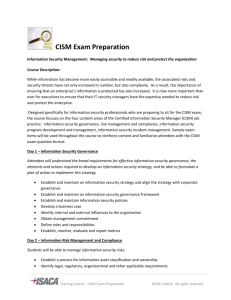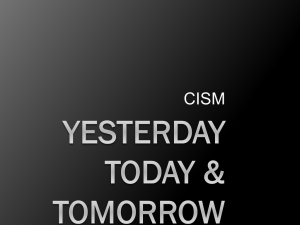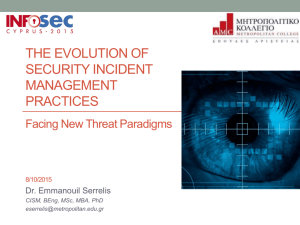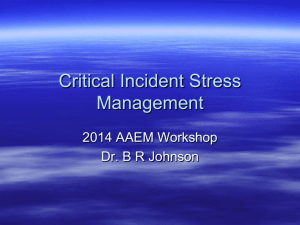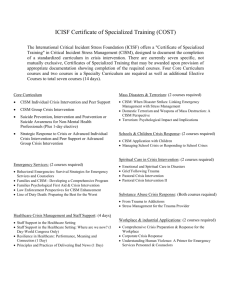Critical Incident Stress
advertisement
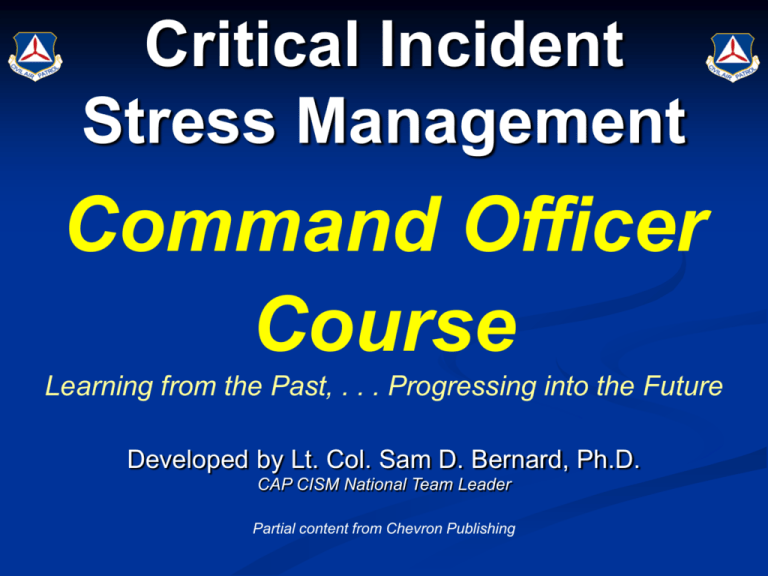
Critical Incident Stress Management Command Officer Course Learning from the Past, . . . Progressing into the Future Developed by Lt. Col. Sam D. Bernard, Ph.D. CAP CISM National Team Leader Partial content from Chevron Publishing Thank you for attending this session concerning CAP Command Officers Rationale To provide Command Staff & Incident Commanders with basic knowledge to: • Recognize the need for CISM, • Implament the CISM program, • Understand basic CISM principles, • Identify distressed personnel under their supervision, • Access CISM services. Goals To provide the knowledge to: Mitigate critical incident stress, Prepare for critical incident stress, Identify critical incident stress, Support interventions for active critical incident stress intervention, Recover from a critical incident while supporting members & the organization in CAP members while performing CAP duties. Agenda • • • • • • • Stress & Types of Stress • CISM Resources Management of • General Functions of Cumulative Stress CISM Teams Recognizing Critical • Follow-Up Services Incident Stress (CIS) • P.A.S.S. Preventing Critical Incident • CAPR 60-5 & Stress (CIS) Updates Jeffrey T. Mitchell, Ph.D., CTS Mitigating Op Stress & • Liability After Action Support George S. Everly, Jr.,• Ph.D., CTS Charge Indicators of CIS vs. • Contact Information Disciplinary Problems or Character Disorders CAP Personality Traits 1. 2. 3. 4. 5. 6. 7. 8. 9. 10. Stress Take Home Message Stress Stress is a state of: • Physical • Cognitive • Behavioral • Emotional and • Spiritual arousal. Once physical, cognitive, emotional and spiritual arousal occurs, behaviors change. Chevron Publishing, 2002 Take Home Message Primary Types of Stress General Stress Cumulative Stress Critical Incident Stress Stress Related Disorder Normal Pathological Having stress is not bad, in itself. What is bad is experiencing excessive or prolonged stress. Chevron Publishing, 2002 Resistance If the stressor continues, the body mobilizes to withstand the stress and return to normal. Alarm The body initially responds to a stressor with changes that lower resistance. Exhaustion Ongoing, extreme stressors eventually deplete the body’s resources so we function at less than normal. Return to homeostasis Stressor The stressor may be threatening or exhilarating. Homeostasis The body systems maintain a stable and consistent (balanced) state. Illness and Death The body’s resources are not replenished and/or additional stressors occur; the body suffers breakdowns. Illness Death The brain becomes more alert. Stress can contribute to headaches, anxiety, and depression. Sleep can be disrupted. Stress hormones can damage the brain’s ability to remember and cause neurons to atrophy and die. Baseline anxiety level can increase. Heart rate increases. Persistently increased blood pressure and heart rate can lead to potential for blood clotting and increase the risk of stroke and heart attack. Adrenal glands produce stress hormones. Cortisol and other stress hormones can increase appetite and thus body fat. Stress can contribute to menstrual disorders in women. Red = immediate response to stress Blue = effects of chronic of prolonged stress Stress can contribute to impotence and premature ejaculation in men. Muscles tense. Muscular twitches or “nervous tics” can result. Mouth ulcers or “cold sores” can crop up. Breathing quickens. The lungs can become more susceptible to colds and infections. Immune system is suppressed. Skin problems such as eczema and psoriasis can appear. Cortisol increases glucose production in the liver, causing renal hypertension. Digestive system slows down. Stress can cause upset stomachs. Red = immediate response to stress Blue = effects of chronic of prolonged stress Health & Performance Stress Curve Maximum adaptive arousal Stress arousal Cumulative Stress Destructive pathway of stress Piled up, unresolved general stress Takes time Produces negative changes in: Mental & physical health Performance Relationships Personality Chevron Publishing, 2002 Cumulative Stress A chronic state of disturbing stress which can cause physical & changes in personality over time. Takes months or years to develop. May be a combination of work or home life. Often referred to as “burnout”. Often needs professional help for recovery especially if in late stages. continued... Cumulative Stress - continued Develops in four stages: Early Warning Mild Symptoms Entrenched Severe Symptoms Characterized by gradually declining performance, increasing problem in job. continued... Cumulative Stress - continued Early Symptoms: Vague anxiety Boredom General fatigue Mild Symptoms: All of the Early Symptoms Irritability Chronic tension Depression continued... Cumulative Stress - continued Mild Symptoms Frustration Frequent sighs Sleep disturbance Chronic worry Loss of interest in work More frequent colds Mild rashes Headaches Withdrawal from others etc.. Entrenched Symptoms Chronic depression Loss of joy of life Chronic anger Increased drinking / drugging Thoughts of suicide Emotional outbursts Marital or relationship discord Conflict with fellow workers Conflict with supervisors Increasing discipline problems continued... Entrenched symptoms - continued Increased self destructive behaviors (i.e.?) Withdrawal from loved ones Continued... Loss of trust in others Increasing paranoia Loss of ambition Tendency to blame others Inability to take responsibility for one’s own actions Minor property destruction Acting out behaviors etc.. (?) Severe Symptoms Rage reactions Homicidal thinking Suicidal thinking / acts Easily angered Verbally violent outbursts Acts of violence Threats to others Excessive drinking / drugging Severe depression Severe paranoia continued... Severe Symptoms - continued Break up of relationships over minor issues Compulsive thinking about bothersome topics Easily frustrated Sense of hopelessness Sense of helplessness Seriously declining performance Most symptoms from previous levels etc.. Burnout Changes attitudes Avoids work Or, becomes totally immersed Develops negative outlook Flame-out Exhaustion, hyperactivity Overwhelming negative emotions Denial of symptoms Loss of objectivity Take Home Message Stress Reactions Physiological not Characteriological Management of Cumulative Stress Reactions Stress management education Balance in life - work - home, etc.. Recreation Vacation Limiting overtime Emphasis on home life Professional counseling when needed continued... Management - continued Exercise Proper food Clear job expectations Reduction of one worker performing two jobs Effective leadership Administrative support Stress reduction techniques Healthy living Effective training Take Home Message Critical Incident An event that has the power to overwhelm the coping abilities of an individual or group. Chevron Publishing, 2002 Take Home Message The Terrible 10 for CAP 1. 6. 2. 7. 3. 8. 4. 9. 5. 10. Take Home Message Crisis Noun vs Verb An acute reaction to a critical incident. A name of a particular critical incident. Crisis Characteristics The relative balance between thought processes and emotional processes is disturbed, The usual coping methods do not work effectively, There is evidence of mild to severe impairment in individuals or groups exposed to the critical incident, Chevron Publishing, 2002 Post CRISIS Pre-CRISIS FEELINGS THOUGHTS FEELINGS THOUGHTS CRISIS Take Home Message Assessing the Need for Crisis Intervention (CISM) Is this one of the CAP “Terrible 10”? Are coping mechanisms working effectively for EVERYONE? Is there evidence of mild to severe impairment in individuals or groups exposed to the critical incident? Critical Incident Stress (CIS) Also called “traumatic stress” Not caused by general stress or cumulative stress, but produced by a specific terrible event All people are vulnerable Emergency personnel may be more vulnerable because of exposure to traumatic events continued... C I S - continued Some may react more strongly than others Usually resolves in a reasonable period of time May need some form of brief support service Can turn into a serious problem for a few people if it is not resolved Supervisors are able to recognize the problem continued... C I S - continued Some people have several Critical Incident Stress reactions during their careers Reactions can be reduced by early intervention Critical Incident Stress can be an opportunity for positive change and growth Chevron Publishing, 2002 Reactions to Stress Physical Cognitive Emotional Behavioral Spiritual Chevron Publishing, 2002 Physical Signs and Symptoms of Critical Incident Stress Thirst Fatigue Nausea Twitches Vomiting Dizziness Elevated B/P Muscle tremors Grinding teeth Visual difficulties Profuse sweating Difficulty breathing Fainting / LoC Weakness/numbess Chest pain Headaches Rapid heart rate Chevron Publishing, 2002 Cognitive Signs and Symptoms of Critical Incident Stress Confusion Nightmares Uncertainty Hypervigilence Suspiciousness Intrusive images Blaming someone Poor problem solving Poor abstract thinking Change in Poor concentration or memory Disorientation Change in alertness Suicide/homicide Hallucinations/delusions Paranoid ideas Disabling guilt Hopelessness Helplessness Chevron Publishing, 2002 Behavioral Signs and Symptoms of Critical Incident Stress Withdrawal Inability to rest Intensified pacing Erratic movements Changes in social activity Changes in speech Changes in appetite Hyper-alertness Chevron Publishing, 2002 Changes in alcohol or drug consumption Antisocial acts Abuse of others Diminished personal hygiene Immobility Self medication Violence Emotional Signs and Symptoms of Critical Incident Stress Guilt Grief Denial Anxiety Agitation Irritability Depression Anger Apprehension Emotional shock Emotional outburst Feeling overwhelmed Loss of emotional control Inappropriate emotional responses Infantile emotions Panic attacks Chevron Publishing, 2002 Spiritual Signs and Symptoms of Critical Incident Stress Angry at “God” Asking “why” questions Cessation of practice of faith Faith rituals fail to have meaning Religious hallucinations or delusions Chevron Publishing, 2002 Cumulative CIS High frequency of activation Long duration of service High intensity of service provision Cumulative CIS Loss of purpose Loss of connection Loss of autonomy Loss of integrity Spiritual depletion Kendall Johnson, 1993 Factors Effecting Crisis Reactions Suddenness Intensity Duration Level of loss Age Injury or death to relatives or friends Availability of resources Level of education / training Availability of coping mechanisms Chevron Publishing, 2002 Crisis Intervention An active and temporary entry into the life of an individual or a group during a period of significant distress. Crisis Intervention Emotional “first aid” designed to assist the person in a crisis state to return to adaptive functioning. Take Home Message Objectives of Crisis Intervention Stabilize situation Mitigate impact Mobilize resources Normalize reactions Restore to adaptive function Chevron Publishing, 2002 Dose Response “1/3 Rule” - Theoretical 1 2 3 8% Imprint of Horror Visual Auditory Olfactory Kinesthetic Gustatory Temporal Psychological / Perceptual Contaminants CISM as Mitigation Efforts attempt to prevent hazards from developing into disasters altogether, or to reduce the effects of disasters when they occur. Differs from the other phases because it focuses on long-term measures for reducing or eliminating risk. Implementation of mitigation strategies can be considered a part of the recovery process if applied after a disaster occurs. CISM as Mitigation Structural or non-structural, Is the most cost-efficient method for reducing the impact of hazards. Does include providing regulations . . . and sanctions against those who refuse to obey the regulations . . . potential risks to the public fema.gov A natural mesh with Public Affairs Take Home Message Mitigating C I S Even with all the right programs, briefings, teams, personnel, etc lined up & available – there can still be CIS. We don’t know our member’s baggage. (Pre-existing conditions) Pre-Exposure Training can help ID potential psych/perceptual contaminants Take Home Message Mitigating Operational Stress (OpStress) Frequent information / feedback to staff Frequent rest breaks Cold or hot environments might require more frequent rest breaks Rest areas away from stimuli 12 hour limit for same scene stimuli Assure proper rehabilitation sector Provide lavatory facilities continued... Take Home Message Mitigating OpStress - continued Provide hand washing facilities Provide medical support to staff Monitor hyper- or hypo-thermia Proper food Limit fat, sugar and salt Fluid replacement Provide drinking water Provide fruit juices Limit use of caffeine products CISM on scene support services continued... Mitigating OpStress - continued Take Home Message Monitor signs of emotional distress Limit overall stimuli at incident Give clear orders to personnel Avoid conflicting orders to staff Delegate authority Frequent rest breaks for all Back up leaders Sectorization of the incident Delegation of authority Credit people for proper actions continued... Take Home Message Mitigating OpStress - continued Limit criticism to absolute minimum Utilize a staging area for uninvolved personnel Limit exposure to event sights, sounds and smells (reminders) Announce time periodically Rotate crews to alternate duties Others ? Peritraumatic Stress Dissociation Intrusive Re-Experiencing Anhedonia, worthlessness, loss of interest in most activities, awakening early, persistent fatigue, and lack of motivation Problematic Substance Use Debilitating worry, nervousness, vulnerability or powerlessness Depression Panic episodes, startle reactions, fighting or temper problems Anxiety Agoraphobic-like social withdrawal Hyperarousal Flashbacks, terrifying memories or night mares, repetitive automatic re-enactments Avoidance Depersonalization, derealization, fugue states, amnesia Abuse or dependency, self-medication Psychotic Symptoms Delusions, hallucinations, bizarre thoughts or images, catatonia Disaster Mental Health Services-A guidebook for Clinicians & Administrators; Dept of Veterans Affairs, 1998 Highest Risk for Extreme Peritraumatic Stress Life-Threatening danger, extreme violence, or sudden death of others; Extreme loss or destruction of their homes, normal lives, and communities; Intense emotional demands from distraught survivors (rescue workers, counselors, caregivers); Prior psychiatric or marital/family problems; Prior significant loss (death of a loved one in the past year) Cardena & Spiegel, 1993; Joseph et.al, 1994; Kooperman, et.al., 1994&5; La Greca et.al.,1996; Lonigan, et.al., 1994; Schwarz & Kowalski, 1991; Shalev, et.al., 1993 Disaster Mental Health Services-A guidebook for Clinicians & Administrators; Dept of Veterans Affairs, 1998 Effects of Hyper-Arousal Trouble sleeping Difficulty concentrating Heightened vigilance Being easily startled Being wary Sudden crying Becoming suddenly angry Being more emotional Panicking Intensified alertness Reminders of the trauma leading to physical reactions Rapid heart beat Sweating etc Increased anxiety Hyper-Arousal Sleep Disturbances Longer to fall asleep Unable to fall asleep More sensitive to noise Awaken more often during the night Have dreams and/or nightmares about the trauma Repetitive trauma dreams may awaken and leave frightened and exhausted Take Home Message After Action Support Thank personnel for their work Consult with CISM team Provide demobilization services on large scale incident Utilize services of CISM teams Arrange defusing for unusual events Consider debriefing for personnel if it appears necessary* continued... Take Home Message After Action Support - continued Allow follow up services by CISM team members Critique incident operationally Teach new procedures from lessons learned Consider the need for family support Other ? Take Home Message Indicators of Critical Incident Stress vs. Disciplinary Problems or Character Disorders Take Home Message Critical Incident Stress Identifiable traumatic event Reactions begin with an event Reactions worsen after event Reactions follow expected patterns Sudden changes are common in CIS CIS reactions usually reduce with: Peer assistance and, With the passage of time Take Home Message Characteriological & Disciplinary Problems - continued Disciplinary problems have a long and diffuse history Problems may have preexisted entry into the CAP job Identifiable traumatic event(s) missing Problems may exist in several other important areas of the person’s life. Problems do not easily resolve over time even with help. Take Home Message Addressing C I S Acknowledge the existence of CIS Pre-incident education Planning Drills / practice Pre-deployment briefings Avoid avoidance of CIS Take Home Message Critical Incident Stress Management Comprehensive Integrated System utilizing a Multi-Tactical Crisis Intervention Approach to Managing Traumatic Stress CISM: Menu of Services Pre-Crisis Preparation Group Intervention Demobilization Crisis Management Briefing Defusing Critical Incident Stress Debriefing Individual Crisis Intervention Pastoral Crisis Intervention Family CISM Organizational Consultation Follow-up/ Referral Take Home Message CISM Tactics Must be Available for: Individuals Groups Organizations Families Significant others Chevron Publishing, 2002 Take Home Message Core Competencies in CISM The ability to properly assess both the situation and the severity of impact on individuals and groups Ability to develop a strategic plan Individual crisis intervention skills Large group crisis intervention skills Small group crisis intervention skills Referral skills Chevron Publishing, 2002 Treatment Referral Options Take Home Message Medical Care Professional MD / DO PA / NP Mental Health Care Professional Psychologist Counselor Social Worker Psychiatrist / NP / PA Spiritual Care Professional Faith Leader “Chaplain” Essential CISM Courses Take Home Message (2 Days Each) Assisting Individuals in Crisis Basic Critical Incident Stress Management: Group Crisis Interventions Suicide Grief Following Trauma Advanced Critical Incident Stress Management: Group Crisis Interventions T.E.A.M. Emotional & Spiritual Care in Disasters Chevron Publishing, 2002 Take Home Message CISM Components Before an Incident Education (PEP) Team training Planning Administrative support Protocol development Guideline development Networking with other teams & resources Take Home Message CISM Components During an Incident On-scene support services One-on-one crisis intervention Advice to supervisors/IC Support to primary victims (CAP) Provision of food, fluids, rest and other services to operations personnel Organizational Consultation (CC) Take Home Message CISM Components After an Incident One-on-one crisis intervention Demobilization (post-disaster, large group) Crisis Management Briefing (CMB, large group) Defusing (small group) Critical Incident Stress Debriefing (CISD, small group) Significant other support services . . . more . . . Take Home Message CISM Components After an Incident continued Post-incident education Follow-up services Referrals according to needs Take Home Message CISM Typically: 3-5 contacts After that, Recovery is evident Referral is indicated Take Home Message CISM Is not psychotherapy Is not a substitute for psychotherapy Is not a stand-alone Is not a cure for PTSD, Depression, Anxiety, etc Take Home Message CISM has far more to do with group support and assessment (triage) than it does with treatment and cure. Take Home Message Follow-Up Must be provided after every CISM service: Assess impact of intervention Assess for uncovering prior issues Assess trajectory of reactions • • • Decreasing Same Increasing Assess for possible referral: Health Care Professional Mental Health Care Professional Spiritual Care Professional P. A. S. S. Post Action Staff Support Dennis Potter, LCSW Goals For PASS Increase longevity of CISM team members Increase learning from the experience Increase stress management skills Decrease the chance for personal reactions To take care of ourselves (too) Increase effectiveness of team members Monitor team for any adverse reactions Why Do It? To Prevent: Vicarious Traumatization Cumulative Stress Critical Self Judgment To Teach To Practice What We Teach “The same professionalism we provide to others, we deserve ourselves” SDB Take Home Message Important Notice: • All CISM services should be provided only by people who have been properly trained in Critical Incident Stress Management courses, • Having attained an advanced academic degree alone does NOT indicate knowledge of CISM or related protocols. International Critical Incident Stress Foundation 3290 Pine Orchard Lane Suite 106 Ellicott City, MD 21042 (410) 750-9600 Fax: (410) 750-9601 Emergency: (410) 313-2473 www.icisf.org CAPR 60-5 Administratively authorizes CISM, Provides background information and “how to” information, Mandates each Wing to name a CISM Officer, Please read and review 60-5 CAP Personality Traits Need to rescue or be needed 2. Strong intrinsic motivation 3. Stimulation seeking/easily bored 4. Need for immediate feedback 5. Action oriented 6. Desire to do a perfect job 7. Need to be in control 8. Strive for consistency 9. Risk taker 10. High dedication 11. Likes uniforms 1. CAP Personality Traits Those 10 traits make us very good at what we do – our jobs in CAP, Those same 10 traits put us at high risk: Cumulative Stress Critical Incident Stress Depression Anxiety Panic Attacks PTSD Substance Abuse Relationship Problems Antisocial traits (isolation, etc) Questions . . . 1. Do CAP members have the potential for attaining physical injury? Yes 2. What is done to address this potential? Safety briefings, Regulations, Checklists, Medical Officers, First Aid kits, Disciplinary actions, etc. 3. Do CAP member have the potential for attaining psychological injury? Yes – direct and indirect 4. What is done to address this potential? CISM program, Regulation 60-5, PEP Talks, Briefings “Deliberate Indifference” U.S. Supreme Court concluded that inadequacy of police training may serve as a basis for municipal liability where failure to train amounts to deliberate indifference for the rights of persons with whom the police come into contact. The Court said that the City of Canton, Ohio was negligent in failing to train their police officers in first aid on a regular basis because the probability of needing to use first aid in police work was so high. Lt. Michael S. Woody, Ret. Akron Ohio Police Dept, Jan 6, 2003 Let’s not put CAP at risk – acknowledge and support the CAP CISM program. “Knowledge itself is power” Sir Francis Bacon “Action is the proper fruit of knowledge” Thomas Fuller What “Actions” from here? Acknowledge the CAP CISM program Designate a CISM Officer or Coordinator Incorporate CISM into each mission Designate CISM specific taskings during evals Allow CISM to support your team and staff by: Triaging mental health issues Helping them cope with their experiences, Getting them back into service Offer referrals if needed Feedback Thoughts Comments Reactions National Staff Lt Col Sam D. Bernard, PhD National CISM Team Leader (423) 322-3297 sam@sambernard.info Maj Chris Latocki Administrative Officer ( 813) 412-9231 clatocki@cism.cap.gov Region Staff ________Name____________ Region CISM Officer Telephone / e-mail ________Name____________ Region Clinical Director Telephone / e-mail Wing Staff ________Name____________ Wing CISM Officer / Coordinator Telephone / e-mail ________Name____________ Wing Clinical Director Telephone / e-mail Sam’s Pearls of Wisdom Who’s needs am I meeting, Just because you can, doesn’t mean you should, Everything that is countable, doesn’t always count; everything is counts is not always countable, Do not confuse effort with results, Listen to the words for the underlying meaning, Have a good day, unless you have made other plans, Timing is all, Bring cognition to chaos, It’s not about you, No one is immune, You will walk with a limp, Hear with your ears, see with your eyes, and think with your brain, It’s bigger than you, Critical Incident Stress Management Lt. Col. Sam D. Bernard, Ph.D. National CAP CISM Team Leader (423) 322-3297Cell sbernard@cism.cap.gov www.sambernard.info cism.cap.gov . . .and just one more thing. . . Thank You! Critical Incident Stress Management Command Officer Course Learning from the Past, . . . Progressing into the Future Developed by Lt. Col. Sam D. Bernard, Ph.D. CAP CISM National Team Leader Partial content from Chevron Publishing
